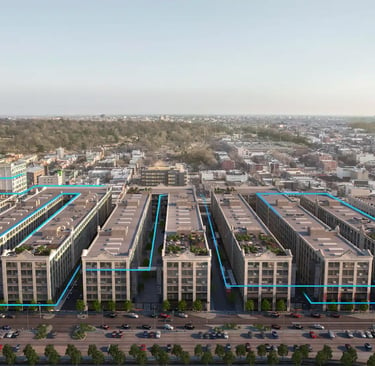The Microsecond Mandate
Why Brooklyn's DataVerge Is NYC's AI Future
James Murphy
10/20/20253 min read


The Microsecond Mandate: Why Brooklyn's DataVerge Is NYC's AI Future
New York City runs on milliseconds. From the frenetic pace of Wall Street trading to the intricate dance of its subway system and the split-second decisions of emergency services, every microsecond counts. But as Artificial Intelligence (AI) moves from the realm of sci-fi to essential urban infrastructure, NYC faces an unprecedented challenge: the distance problem.
The data center revolution isn't just happening in distant, sprawling campuses in Virginia. For AI to truly power a smart, resilient, and equitable New York, the compute must move closer. This is the Edge, and facilities like DataVerge in Brooklyn are demonstrating exactly why they're critical to NYC's AI future.
I. AI Inference: The Need for Speed at New York's Edge
We're not talking about AI Training here—the brute-force process of teaching AI models, which can happen far away in hyperscale cloud data centers. We're talking about AI Inference: the real-time application of that learned intelligence to make immediate decisions.
Consider these NYC scenarios where latency (the delay in data transmission) is simply unacceptable:
Smart Traffic Optimization: AI analyzing real-time video feeds from Midtown intersections to adjust signal timing. If the data has to travel to New Jersey or Virginia for processing, the traffic jam has already formed.
Subway Predictive Maintenance: Sensors detecting micro-fractures on tracks. An AI inference model needs to flag that immediately for crew dispatch, not hours later.
Power Grid Load Balancing: AI automatically shifting energy load during a heatwave to prevent brownouts. Any delay risks critical infrastructure failure.
Financial Trading: AI-driven algorithms making instantaneous buy/sell decisions. Even a few milliseconds can mean millions lost.
For NYC, Edge AI Infrastructure isn't a luxury; it's the only way to deliver the sub-millisecond responsiveness required for safety, efficiency, and economic competitiveness.
II. DataVerge: Power, Proximity, and the Brooklyn Advantage
To support AI Inference at this scale, a data center needs two things above all else: immense, high-density power capacity and ultra-low-latency connectivity. This is where an urban, carrier-neutral facility like DataVerge, nestled within Brooklyn's Industry City, becomes a game-changer.
1. Power Density: The AI Bottleneck Solved
AI workloads are power-hungry beasts. Modern GPU server racks, essential for AI inference, demand exponentially more power (often 30-60kW per rack, sometimes much more) than traditional IT equipment. This immediately strains urban electrical grids designed for distributed residential and commercial loads.
The 40 MW Substation Advantage: DataVerge's access to a 40-megawatt substation directly on-site at Industry City is its secret weapon. This isn't just "some" power; it's a massive, dedicated utility resource in a borough where securing new high-capacity feeds is a monumental challenge. This enables DataVerge to offer:
Over 1 megawatt of dedicated IT power, ready for immediate deployment.
Specialized 200kW cold-air containment pods designed specifically to cool dense AI hardware clusters, addressing the significant thermal management challenges of high-density GPUs.
Redundancy for Reliability: With N+1 and 2N redundant power distribution, DataVerge ensures the five-nines uptime (99.999%) that AI-driven critical systems in NYC demand.
This combination of raw power access and purpose-built cooling infrastructure makes DataVerge a rare commodity, uniquely positioned to host the compute engines of NYC's AI future.
2. Carrier-Neutral Interconnection: The Connectivity Nexus
Beyond power, seamless, low-latency data flow is paramount. DataVerge's status as Brooklyn's only carrier-neutral interconnection facility makes it a pivotal hub.
Ecosystem of Connectivity: Housing over 40 network operators and cloud providers, DataVerge is a digital melting pot. This deep ecosystem means any AI firm can establish direct, private connections to virtually every major network backbone and hyperscale cloud platform (AWS, Azure, Google Cloud).
Hybrid AI Strategy: This direct connectivity enables a crucial hybrid AI strategy: companies can conduct their compute-intensive AI training in remote, cost-effective cloud regions and then seamlessly transfer those trained models to DataVerge for ultra-low-latency inference at the urban edge.
Brooklyn's Digital Lifeline: DataVerge extends fiber laterals throughout the sprawling Industry City campus, providing essential "last mile" connectivity for hundreds of local businesses and positioning itself as Brooklyn's primary point of digital interconnection.
III. The P3PC Mandate: Building an Equitable AI-Ready NYC
For New York City, the emergence of AI Inference at the Edge isn't just a technical challenge; it's a P3PC (Public-Private-People-Planet-Capital) mandate.
Public (City Planning): City planners must proactively integrate zoning for high-power-density zones, facilitate utility upgrades, and recognize facilities like DataVerge as critical infrastructure.
Private (DataVerge, Tech Firms): Private providers offer the essential compute and connectivity, transforming traditional industrial assets into digital capital.
People (Citizens): Local AI inference means faster, more reliable, and potentially more equitable services, from safer subways to optimized emergency responses, directly impacting the quality of urban life.
Planet (Sustainability): Optimizing the power grid for AI also means leveraging renewable sources and efficient cooling to minimize the environmental footprint of these new digital demands.
DataVerge in Brooklyn isn't just a data center; it's a blueprint for how New York City can meet the microsecond mandate of AI, ensuring its continued leadership in innovation, resilience, and urban living. The future of NYC is being powered at the Edge.
Connect
Partnering for a better Municipalities everywhere.
#IMPACT
#SmartCommunity
© 2025. All rights reserved.
